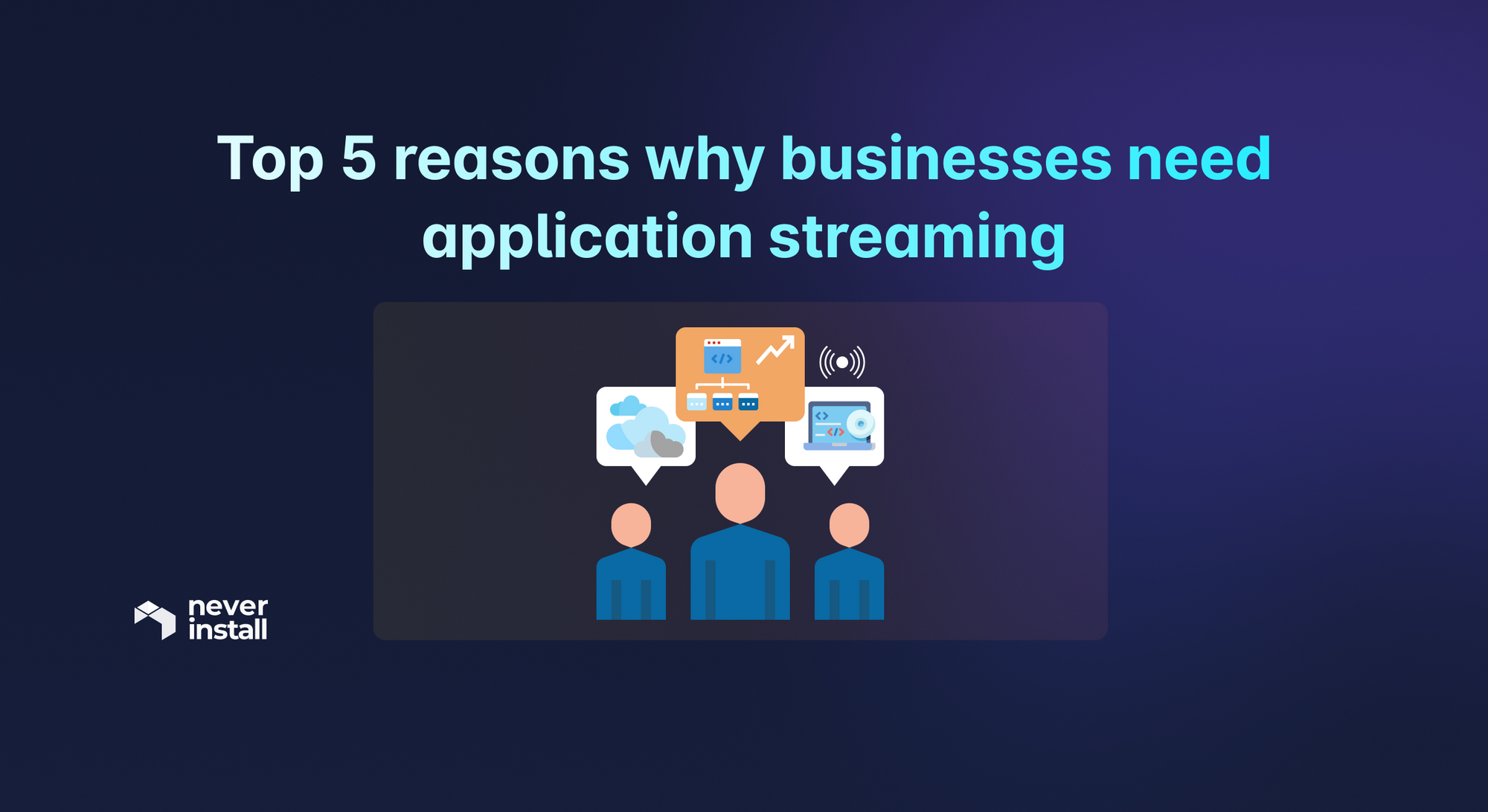Before examining how application streaming can benefit your business, here are some remote work statistics:
- 55% of Americans believe that remote work can thrive in their industry.
- 36.2 million Americans will be remotely working by 2025.
- Remote job openings on LinkedIn have increased by over 350%.
- 64% of employees might quit if asked to return to the office full-time.
Since remote work has clearly become a fixture in global employment, companies have naturally been exploring ways to facilitate employee productivity, speed, and accuracy across local or global locations. Executives have also been grappling with concerns about employee endpoint security, shadow IT, vendor payments for hardware or software fixes, and roadblocks with onboarding new employees.
However, a great solution to these concerns is fairly simple - application streaming.
This article will outline five reasons for adopting application streaming by businesses with a remote employee pool. In all honesty, though, the reasons could apply equally emphatically to in-office workspaces since eliminating in-house infrastructure would contribute to reduced expenditure and improved workflows regardless of the employee’s location.
But first, a quick overview.
Understanding application streaming
Essentially, application streaming is the practice of using desktop applications through a browser. Users can access a personal desktop through their browser in the same way as accessing a website. The desktop operates as a web app and hosts all tools required for daily tasks - including apps for design, software development, project management, inter and intra-team communication, etc.
The process is quite like streaming Netflix videos, except in this case, you interact with every tool, button, link, and UI element on your browser-based desktop. The kicker is that each app, tool, or other browsers you work with on this desktop doesn’t use your device’s computing power to operate. Everything feeds off remote servers so you can run resource-intensive tools (Figma, VSCode, Obsidian, etc.) on low-spec devices like Chromebooks.
Suggested read: The best way to run heavy apps on a Chromebook
Literally, all your device has to do is connect to the internet and run a single tab on a browser; powerful cloud servers accomplish everything else. You get a full-fledged OS via your browser, with pre-configured, pre-installed apps and tools that work exactly as they would on your local device (or probably better, since they no longer depend on your device’s hardware/software capacities).
Suggested read: Familiar in the Cloud: Streaming the native desktop experience to your browser
Top five reasons for businesses to use application streaming
Superior data security
A major concern around remote work is that employees’ devices are away from a centralized location, making it difficult for IT teams to monitor their usage. With devices spread across multiple locations, IT teams have a harder time preventing data theft, breaches, or unauthorized access. If an employee's device is stolen or misplaced, the company faces the threat of having sensitive or confidential data viewed or manipulated by threat actors.
However, with application streaming in the picture, this concern disappears. All company data, or any data the user works with on their browser-accessible desktop, is stored on remote servers. Nothing touches the device’s local storage (you can mandate that your employees do not download data from the cloud desktop to their local device).
Because of this, no one without the proper credentials and permissions can touch the data, even if they have the device in their hands. Even if the laptop/tablet is lost, the data remains secure. And if the employee has not logged out of their virtual desktop, the IT team can remotely lock that particular workspace, preventing data loss.
Consequently, businesses no longer have to worry about losing intellectual property, which lowers the chance of revenue dips and competitor tactics. Additionally, since the process is much simpler than securing data on in-house databases, you get this increased security at a significantly lower cost.
Device-independent productivity
As mentioned before, application streaming doesn’t consume the processing power of the actual device being used to access the cloud desktop. It runs off remote servers built to handle the operational overhead of running heavy apps.
Consequently, as long as an employee device is capable of internet connectivity and launching a browser (as almost all devices are), employees are not limited by the particular hardware and software specs of said device. For example, a Neverinstall user can run the latest design and dev tools flawlessly on a Chromebook. They can also run these tools on the cloud desktop at higher internet speeds than currently available at their location.
Application streaming promises consistently high productivity levels by removing the lag and system crashes that often occur if users try to run high-requirement tools on low-spec devices. Employees don’t have to deal with the frustration of waiting for tasks to process or beat their heads against the wall as the laptop keeps crashing when compiling code.
The app streaming provider automatically keeps adding newer versions of tools and apps, all of which your employees can continue to run on their existing devices. You no longer have to buy the latest Macbook Pro (or keep updating on older ones) to keep up with advancing tech. Needless to say, this feature also allows significant savings for employers.
Suggested read: How Cloud PCs simplify the use of Remote Work Platforms
Lower maintenance costs and increased ROI
Since apps run on remote servers, employee devices don’t deal with the usual resource consumption and hardware degradation. Consequently, this reduces IT maintenance expenses. If an issue with the virtual workspace occurs, employees don’t have to ship or take it to an appropriate support center. Support teams can examine, diagnose and fix emergent problems via remote access.
IT teams can also trigger security and performance updates and remotely monitor inappropriate usage patterns.
Add to that the fact that employees can use resource-intensive apps on reasonably priced devices effortlessly, and you bring noticeably higher ROI into the picture. When a business doesn’t have to keep spending on devices with sufficient RAM or GPU to keep up with power users (devs, designers, etc.), they save the money that would otherwise be spent on buying new devices, more server space, or on disposing of older devices.
Easier employee onboarding and access to a wider talent pool
A cloud-based workspace allows businesses to set up application streaming, initialized, customized, and ready for use in just a few minutes. That means new employees don’t have to wait for company-issued and configured devices to reach them before they start working. As long as they have a device, they can receive workspace credentials, connect to the internet and start with their tasks.
The onboarding process also becomes shorter and simpler since employees don’t have to calibrate their devices according to company protocols - download and set up specific anti-virus software, report device status, and the like. They don’t have to set up anything – simply log in and start work.
A more straightforward onboarding process lets businesses hire talented individuals from cities, towns, countries, and continents. As long as candidates can access the internet at reasonable speeds, nothing restricts them from working for an employer choosing to stream applications.
Improved customer experience
Even beyond the employee pool, application streaming can also facilitate better customer experiences across use cases. For example, customer support personnel can use collaborative browsing to guide a customer with issues/bugs/confusion on their end. It’s much easier to see a problem show up in real-time, and support staff can quickly and easily guide the customer on solving the said problem without any need for screen sharing.
Collaborative browsing is equally effective in other scenarios, such as document review, code review, and customer onboarding, irrespective of location or industry. It helps to minimize the barriers between support and customer, enabling faster and better redressal of concerns and boosting customer trust.
Read more: Collaborative Browsing: A virtual solution for real-time participation
Leverage business-ready application streaming with Neverinstall
Application streaming for businesses has never been easier than it is with Neverinstall. Obviously, we would say that, but we’re more than willing to walk the talk. To start with, here’s a glimpse of features Neverinstall users can utilize once they sign up:
- A fully-functional browser-based Linux OS, windows is accessible and usable via any device with an internet connection, including mobile devices.
- A desktop experience that caters to mobile device users, equipped with responsive design, single-touch & multi-touch interactions, and a virtual keyboard.
- Full customization abilities.
- Popular applications used across industries, all pre-installed and pre-configured. Get tools like Figma, Slack, VSCode, Android Studio, Discord & more with no limitations in features or functionality.
- Launch workspaces via servers in the US and Europe to allow users to work with high-speed internet connections even with modest bandwidth on local machines, no matter where they are.
- Industry-leading low latency via the WebRTC streaming protocols.
- Effortless input acceptance via keyboard and mouse.
- An expanding server network driven by Neverinstall’s intent to reduce operational latency to the lowest possible levels. Neverinstall uses server clusters in the US, England, Singapore, and India. Upcoming servers will cover Japan, Australia, Finland, Spain, The Netherlands, and more locations in the US.
If you want a more detailed exploration of everything, Neverinstall workspaces offer, look at Spaces by Neverinstall.
Final thoughts
Application streaming can realistically empower businesses to unlock new facets of productivity, ease of work, security, and accessibility. The enormous advantage of working from anywhere with an internet connection breaks down the barriers of geography. At the same time, the ability to run heavy apps on basic devices eliminates monetary limitations.
Essentially, application streaming makes it possible to access enterprise-grade software at lower costs than would be possible with in-house infrastructure. Small and mid-sized businesses, in particular, can gain a serious competitive edge by using best practice-driven tools, apps, and internet strengths without dipping into a financial war chest that they often do not have. They can achieve optimal productivity levels while paying much less than they would to host those apps and purchase employee devices by themselves.
Experience browser-based computing with Neverinstall and offload your heavy-duty applications to the cloud - without breaking the bank.
Create a Space and experience Neverinstall today!
Author: Shreya Bose
Shreya is a seasoned tech writer. Apart from technology, she loves writing about healthcare, heavy metal, alcohol, and coffee. When she is not writing, she is reading, drinking tea, and waiting for naptime.


